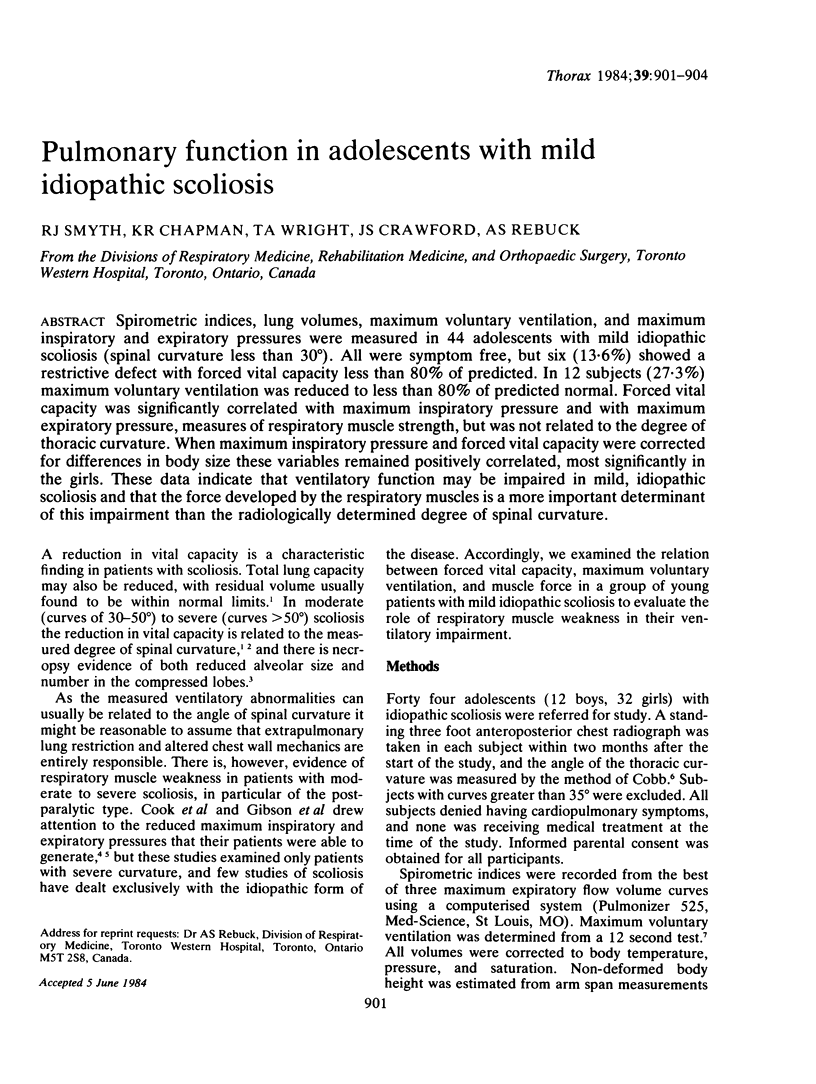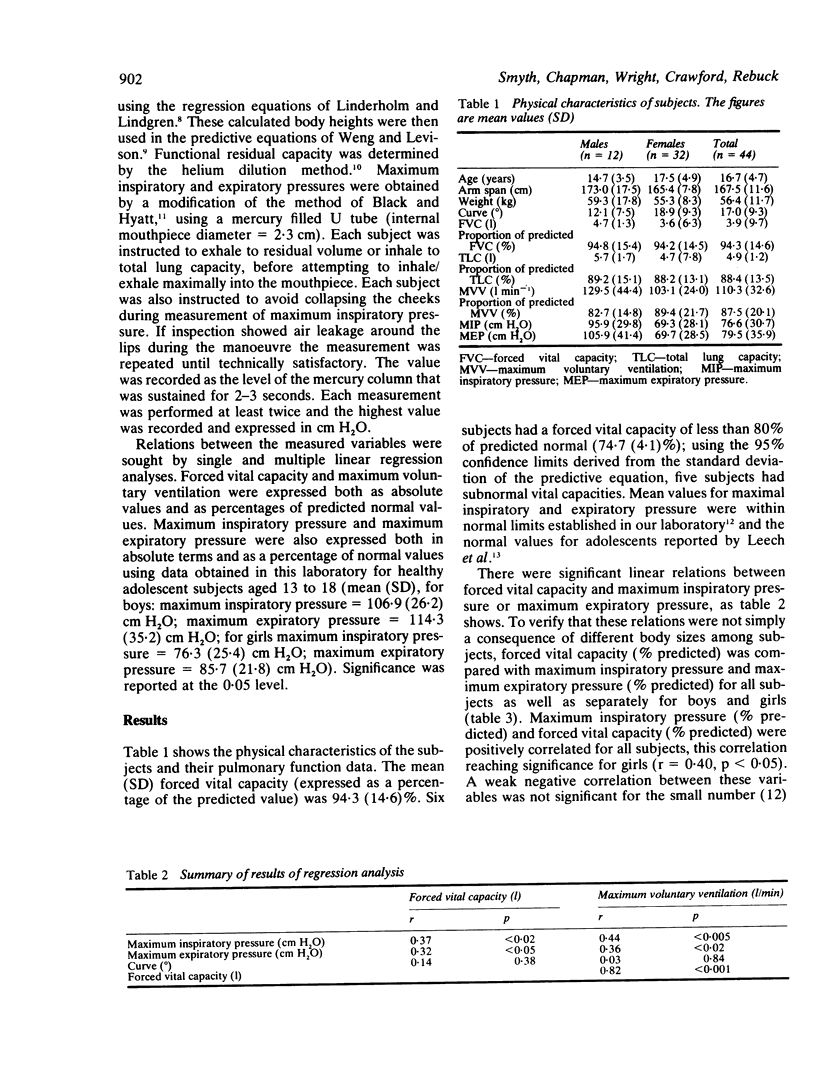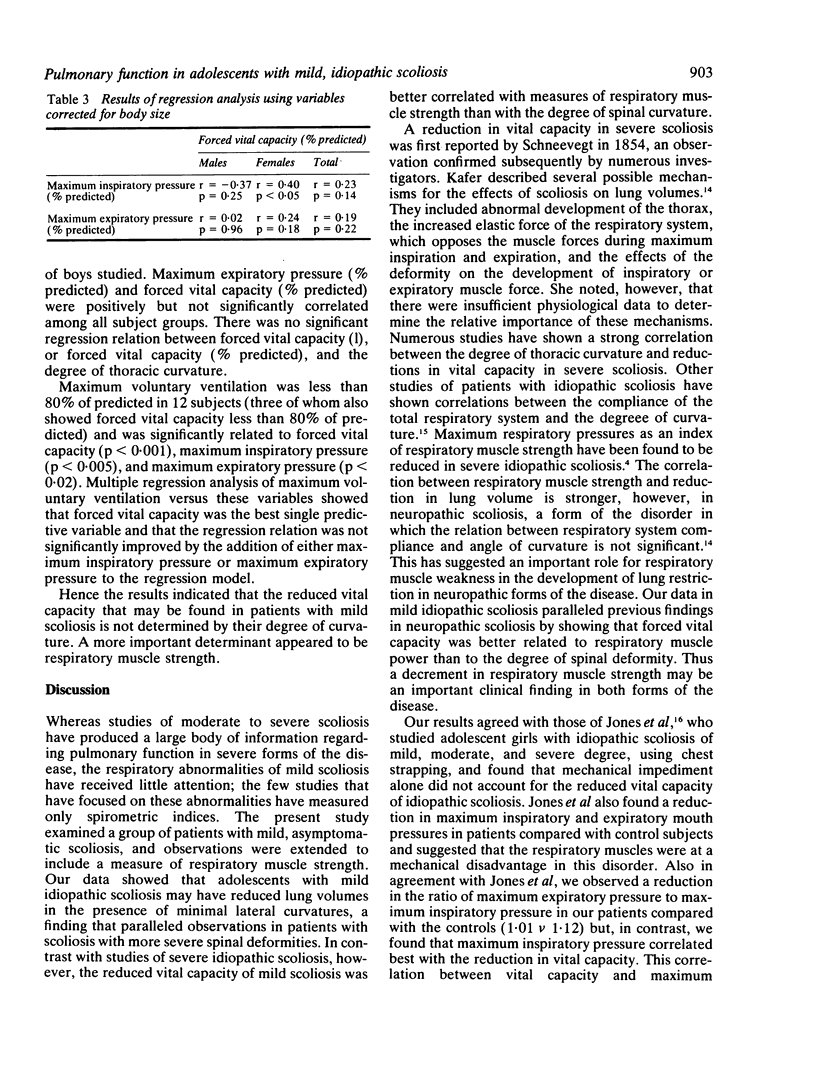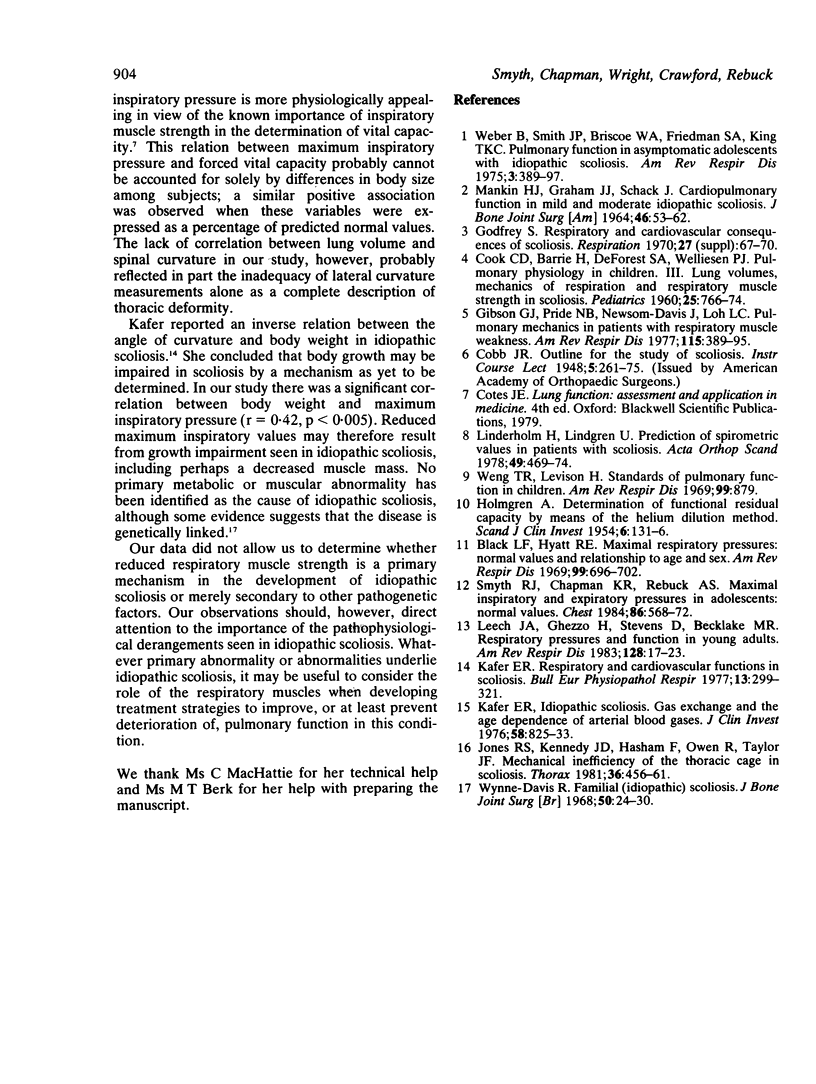Abstract
Spirometric indices, lung volumes, maximum voluntary ventilation, and maximum inspiratory and expiratory pressures were measured in 44 adolescents with mild idiopathic scoliosis (spinal curvature less than 30 degrees). All were symptom free, but six (13.6%) showed a restrictive defect with forced vital capacity less than 80% of predicted. In 12 subjects (27.3%) maximum voluntary ventilation was reduced to less than 80% of predicted normal. Forced vital capacity was significantly correlated with maximum inspiratory pressure and with maximum expiratory pressure, measures of respiratory muscle strength, but was not related to the degree of thoracic curvature. When maximum inspiratory pressure and forced vital capacity were corrected for differences in body size these variables remained positively correlated, most significantly in the girls. These data indicate that ventilatory function may be impaired in mild, idiopathic scoliosis and that the force developed by the respiratory muscles is a more important determinant of this impairment than the radiologically determined degree of spinal curvature.
Full text
PDF



Selected References
These references are in PubMed. This may not be the complete list of references from this article.
- Black L. F., Hyatt R. E. Maximal respiratory pressures: normal values and relationship to age and sex. Am Rev Respir Dis. 1969 May;99(5):696–702. doi: 10.1164/arrd.1969.99.5.696. [DOI] [PubMed] [Google Scholar]
- COOK C. D., BARRIE H., DEFOREST S. A., HELLIESEN P. J. Pulmonary physiology in children. III. Lungvolumes, mechanics of respiration and respiratory muscle strength in scoliosis. Pediatrics. 1960 May;25:766–774. [PubMed] [Google Scholar]
- Gibson G. J., Pride N. B., Davis J. N., Loh L. C. Pulmonary mechanics in patients with respiratory muscle weakness. Am Rev Respir Dis. 1977 Mar;115(3):389–395. doi: 10.1164/arrd.1977.115.3.389. [DOI] [PubMed] [Google Scholar]
- Godfrey S. Respiratory and cardiovascular consequences of scoliosis. Respiration. 1970;27(Suppl):67–70. doi: 10.1159/000192722. [DOI] [PubMed] [Google Scholar]
- HOLMGREN A. Determination of the functional residual volume by means of the helium dilution method. Scand J Clin Lab Invest. 1954;6(2):131–136. doi: 10.3109/00365515409134854. [DOI] [PubMed] [Google Scholar]
- Jones R. S., Kennedy J. D., Hasham F., Owen R., Taylor J. F. Mechanical inefficiency of the thoracic cage in scoliosis. Thorax. 1981 Jun;36(6):456–461. doi: 10.1136/thx.36.6.456. [DOI] [PMC free article] [PubMed] [Google Scholar]
- Kafer E. R. Idiopathic scoliosis. Gas exchange and the age dependence of arterial blood gases. J Clin Invest. 1976 Oct;58(4):825–833. doi: 10.1172/JCI108535. [DOI] [PMC free article] [PubMed] [Google Scholar]
- Kafer E. R. Respiratory and cardiovascular functions in scoliosis. Bull Eur Physiopathol Respir. 1977 Mar-Apr;13(2):299–321. [PubMed] [Google Scholar]
- Leech J. A., Ghezzo H., Stevens D., Becklake M. R. Respiratory pressures and function in young adults. Am Rev Respir Dis. 1983 Jul;128(1):17–23. doi: 10.1164/arrd.1983.128.1.17. [DOI] [PubMed] [Google Scholar]
- Linderholm H., Lindgren U. Prediction of spirometric values in patients with scoliosis. Acta Orthop Scand. 1978 Oct;49(5):469–474. doi: 10.3109/17453677808993264. [DOI] [PubMed] [Google Scholar]
- MANKIN H. J., GRAHAM J. J., SCHACK J. CARDIOPULMONARY FUNCTION IN MILD AND MODERATE IDIOPATHIC SCOLIOSIS. J Bone Joint Surg Am. 1964 Jan;46:53–62. [PubMed] [Google Scholar]
- Smyth R. J., Chapman K. R., Rebuck A. S. Maximal inspiratory and expiratory pressures in adolescents. Normal values. Chest. 1984 Oct;86(4):568–572. doi: 10.1378/chest.86.4.568. [DOI] [PubMed] [Google Scholar]
- Weber B., Smith J. P., Briscoe W. A., Friedman S. A., King T. K. Pulmonary function in asymptomatic adolescents with idiopathic scoliosis. Am Rev Respir Dis. 1975 Apr;111(4):389–397. doi: 10.1164/arrd.1975.111.4.389. [DOI] [PubMed] [Google Scholar]
- Weng T. R., Levison H. Standards of pulmonary function in children. Am Rev Respir Dis. 1969 Jun;99(6):879–894. doi: 10.1164/arrd.1969.99.6.879. [DOI] [PubMed] [Google Scholar]
- Wynne-Davies R. Familial (idiopathic) scoliosis. A family survey. J Bone Joint Surg Br. 1968 Feb;50(1):24–30. [PubMed] [Google Scholar]


